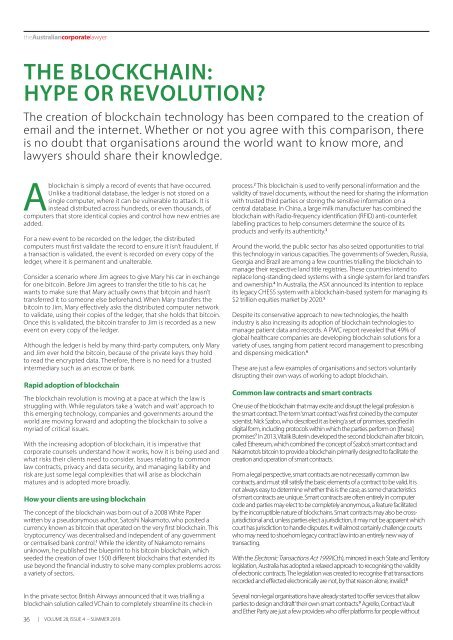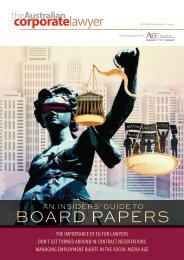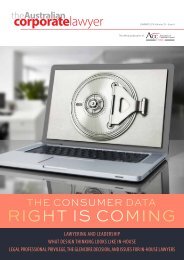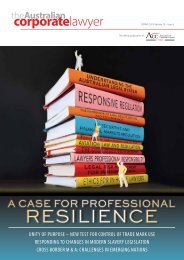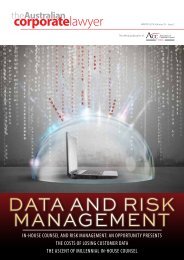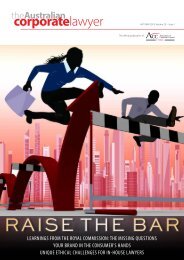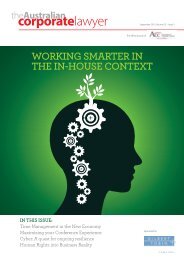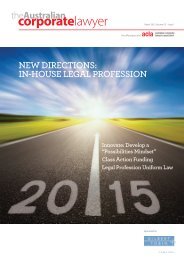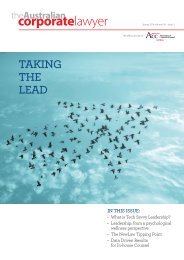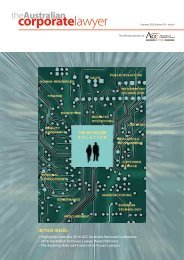Australian Corporate Lawyer - Summer 2018
Australian Corporate Lawyer is the official publication of the Association of Corporate Counsel (ACC) Australia. The Summer 2018 issue focuses on technology and features a range of articles covering topics including: The opportunity for legal innovation; digitalisation, technology and innovation are changing in-house legal teams; and six steps to overcome resistance to technology change.
Australian Corporate Lawyer is the official publication of the Association of Corporate Counsel (ACC) Australia. The Summer 2018 issue focuses on technology and features a range of articles covering topics including: The opportunity for legal innovation; digitalisation, technology and innovation are changing in-house legal teams; and six steps to overcome resistance to technology change.
Create successful ePaper yourself
Turn your PDF publications into a flip-book with our unique Google optimized e-Paper software.
the<strong>Australian</strong>corporatelawyer<br />
acla.acc.com<br />
THE BLOCKCHAIN:<br />
HYPE OR REVOLUTION?<br />
The creation of blockchain technology has been compared to the creation of<br />
email and the internet. Whether or not you agree with this comparison, there<br />
is no doubt that organisations around the world want to know more, and<br />
lawyers should share their knowledge.<br />
A<br />
blockchain is simply a record of events that have occurred.<br />
Unlike a traditional database, the ledger is not stored on a<br />
single computer, where it can be vulnerable to attack. It is<br />
instead distributed across hundreds, or even thousands, of<br />
computers that store identical copies and control how new entries are<br />
added.<br />
For a new event to be recorded on the ledger, the distributed<br />
computers must first validate the record to ensure it isn’t fraudulent. If<br />
a transaction is validated, the event is recorded on every copy of the<br />
ledger, where it is permanent and unalterable.<br />
Consider a scenario where Jim agrees to give Mary his car in exchange<br />
for one bitcoin. Before Jim agrees to transfer the title to his car, he<br />
wants to make sure that Mary actually owns that bitcoin and hasn’t<br />
transferred it to someone else beforehand. When Mary transfers the<br />
bitcoin to Jim, Mary effectively asks the distributed computer network<br />
to validate, using their copies of the ledger, that she holds that bitcoin.<br />
Once this is validated, the bitcoin transfer to Jim is recorded as a new<br />
event on every copy of the ledger.<br />
Although the ledger is held by many third-party computers, only Mary<br />
and Jim ever hold the bitcoin, because of the private keys they hold<br />
to read the encrypted data. Therefore, there is no need for a trusted<br />
intermediary such as an escrow or bank.<br />
Rapid adoption of blockchain<br />
The blockchain revolution is moving at a pace at which the law is<br />
struggling with. While regulators take a ‘watch and wait’ approach to<br />
this emerging technology, companies and governments around the<br />
world are moving forward and adopting the blockchain to solve a<br />
myriad of critical issues.<br />
With the increasing adoption of blockchain, it is imperative that<br />
corporate counsels understand how it works, how it is being used and<br />
what risks their clients need to consider. Issues relating to common<br />
law contracts, privacy and data security, and managing liability and<br />
risk are just some legal complexities that will arise as blockchain<br />
matures and is adopted more broadly.<br />
How your clients are using blockchain<br />
The concept of the blockchain was born out of a 2008 White Paper<br />
written by a pseudonymous author, Satoshi Nakamoto, who posited a<br />
currency known as bitcoin that operated on the very first blockchain. This<br />
‘cryptocurrency’ was decentralised and independent of any government<br />
or centralised bank control. 1 While the identity of Nakamoto remains<br />
unknown, he published the blueprint to his bitcoin blockchain, which<br />
seeded the creation of over 1500 different blockchains that extended its<br />
use beyond the financial industry to solve many complex problems across<br />
a variety of sectors.<br />
process. 2 This blockchain is used to verify personal information and the<br />
validity of travel documents, without the need for sharing the information<br />
with trusted third parties or storing the sensitive information on a<br />
central database. In China, a large milk manufacturer has combined the<br />
blockchain with Radio-frequency identification (RFID) anti-counterfeit<br />
labelling practices to help consumers determine the source of its<br />
products and verify its authenticity. 3<br />
Around the world, the public sector has also seized opportunities to trial<br />
this technology in various capacities. The governments of Sweden, Russia,<br />
Georgia and Brazil are among a few countries trialling the blockchain to<br />
manage their respective land title registries. These countries intend to<br />
replace long-standing deed systems with a single system for land transfers<br />
and ownership. 4 In Australia, the ASX announced its intention to replace<br />
its legacy CHESS system with a blockchain-based system for managing its<br />
$2 trillion equities market by 2020. 5<br />
Despite its conservative approach to new technologies, the health<br />
industry is also increasing its adoption of blockchain technologies to<br />
manage patient data and records. A PWC report revealed that 49% of<br />
global healthcare companies are developing blockchain solutions for a<br />
variety of uses, ranging from patient record management to prescribing<br />
and dispensing medication. 6<br />
These are just a few examples of organisations and sectors voluntarily<br />
disrupting their own ways of working to adopt blockchain.<br />
Common law contracts and smart contracts<br />
One use of the blockchain that may excite and disrupt the legal profession is<br />
the smart contract. The term ‘smart contract’ was first coined by the computer<br />
scientist, Nick Szabo, who described it as being ‘a set of promises, specified in<br />
digital form, including protocols within which the parties perform on [these]<br />
promises’. 7 In 2013, Vitalik Buterin developed the second blockchain after bitcoin,<br />
called Ethereum, which combined the concept of Szabo’s smart contract and<br />
Nakamoto’s bitcoin to provide a blockchain primarily designed to facilitate the<br />
creation and operation of smart contracts.<br />
From a legal perspective, smart contracts are not necessarily common law<br />
contracts, and must still satisfy the basic elements of a contract to be valid. It is<br />
not always easy to determine whether this is the case, as some characteristics<br />
of smart contracts are unique. Smart contracts are often entirely in computer<br />
code and parties may elect to be completely anonymous, a feature facilitated<br />
by the incorruptible nature of blockchains. Smart contracts may also be crossjurisdictional<br />
and, unless parties elect a jurisdiction, it may not be apparent which<br />
court has jurisdiction to handle disputes. It will almost certainly challenge courts<br />
who may need to shoehorn legacy contract law into an entirely new way of<br />
transacting.<br />
With the Electronic Transactions Act 1999 (Cth), mirrored in each State and Territory<br />
legislation, Australia has adopted a relaxed approach to recognising the validity<br />
of electronic contracts. The legislation was created to recognise that transactions<br />
recorded and effected electronically are not, by that reason alone, invalid. 8<br />
legal or computer science backgrounds to quickly prepare and execute legally<br />
binding smart contracts. It may not be long before judges are reading ‘if’ and ‘then’<br />
statements in a programmer’s code instead of the carefully crafted clauses and<br />
headings of a contract lawyer.<br />
Privacy and the blockchain<br />
Commentators and technologists became more interested in the interplay<br />
between privacy regulations and the blockchain when the European Union’s<br />
(EU) General Data Protection Regulations (GDPR) commenced in May this<br />
year. One benefit of the blockchain, which may be at odds with privacy<br />
legislation, is its immutable nature. You will recall that once a transaction is<br />
recorded on the blockchain, it is permanent and cannot be erased. While this<br />
feature is a tenet of blockchain technology, it flies in the face of Article 17 of<br />
the GDPR. This provision provides EU data subjects the right to be forgotten<br />
and, under certain circumstances, requires a data controller to erase any<br />
personal data it holds about them. While it may be easy to dismiss this as a<br />
problem for European countries, the borderless nature of the blockchain and<br />
the unprecedented extraterritorial effect of the GDPR makes this an important<br />
consideration which <strong>Australian</strong> lawyers should consider.<br />
Similar concerns surround <strong>Australian</strong> privacy laws. Companies looking to<br />
trial blockchain should start to consider how local privacy laws will affect<br />
their solutions, particularly if they decide to store personal information. While<br />
it is probably too early for courts and legislators to specifically deal with<br />
blockchain, Australia is leading the way with privacy regulations. The Australia<br />
Standards recently made recommendations to the International Organisation<br />
for Standardisation, stating that privacy, security and identity issues should be<br />
prioritised as the industry develops uniform blockchain standards. 10<br />
It is likely that <strong>Australian</strong> privacy law will be more malleable than the GDPR<br />
when it comes to regulating the blockchain. Under the federal privacy<br />
regime, the source of these obligations is in the Privacy Act 1999 (Cth) (Privacy<br />
Act), including the <strong>Australian</strong> Privacy Principles (APPs) that govern many<br />
organisations around the country. It’s important to note that just because data<br />
stored on a blockchain may be encrypted, it does not mean that it cannot be<br />
reasonably identifiable and therefore outside of the operation of the Privacy<br />
Act and APPs. While encrypted data may obscure original information, it can<br />
easily be de-identified with a decryption key, so it is best to assume that the<br />
Privacy Act will still apply. 11<br />
Unlike the GDPR, the Privacy Act and APPs do not provide for an equivalent<br />
‘right to be forgotten’; however, there are similar obligations related to taking<br />
reasonable efforts to ensure that personal information is accurate and up to<br />
date. 12 Arguably, what is ‘reasonable’ may take into account the impossibility<br />
of deleting entries in the blockchain, a leniency which the GDPR fails to take<br />
into account. Another aspect that should be considered is how personal<br />
information is collected and stored, particularly given the distributed and<br />
cross-jurisdictional nature of the blockchain. 13<br />
Organisations subject to the Privacy Act, APPs or any state-based privacy<br />
legislation should consider the effect of the privacy laws on their proposed<br />
blockchain solutions. <strong>Lawyer</strong>s should review their privacy statements to<br />
ensure they accurately reflect how personal information is stored and<br />
handled. Some commentators have compared the creation of the blockchain<br />
Blockchains and liability<br />
Replacing contracts with code, and centralised storage with distributed<br />
ledgers, will create some commercial and practical efficiencies; however, this<br />
may be at the cost of unquantifiable risk. Before lawyers hand over the keys to<br />
computer programmers, they should take a moment to reflect on the times<br />
when things did not go to plan.<br />
The Decentralised Autonomous Organisation (DAO) is a decentralised venture<br />
capital fund that uses blockchain to democratically fund blockchain projects.<br />
In May 2017, a hacker was able to take advantage of a critical programming<br />
error to re-direct approximately US$70m to the hacker’s account in a matter<br />
of hours. 14<br />
portion of the code that was deleted irreversibly froze the funds of around 500<br />
wallets, a total of US$160m in funds. 15<br />
These two examples represent a few high-profile instances of what can go<br />
wrong; however, these are just a small sample of instances where nefarious<br />
actors and poor-quality control led to disastrous outcomes. While the<br />
potential for blockchain is endless, it is important to recognise the risks it<br />
poses, especially where large sums of money or critical information is at<br />
stake. <strong>Lawyer</strong>s will play a vital role, working with software and information<br />
technology teams, to help identify and manage risk to avoid catastrophic<br />
outcomes such as those illustrated by DAO and Parity incidents.<br />
In the private sector, British Airways announced that it was trialling a Several non-legal organisations have already started to offer services that allow<br />
An organisation called Parity also came under scrutiny when one of their<br />
blockchain solution called VChain to completely streamline its check-in parties to design and ‘draft’ their own smart contracts. 9 Agrello, Contract Vault<br />
software developers accidentally deleted part of its source code. Parity<br />
and Ether Party are just a few providers who offer platforms for people without<br />
operates as a wallet for clients wishing to access their cryptocurrencies. The<br />
36 | VOLUME 28, ISSUE 4 – SUMMER <strong>2018</strong> VOLUME 28, ISSUE 4 – SUMMER <strong>2018</strong> | 37<br />
Conclusion<br />
Some commentators have compared the creation of the blockchain with<br />
the creation of email or the TCP/IP protocol, which allows us to use the<br />
internet. Regardless of whether this is an exaggeration, there is no denying<br />
that around the world, we are seeing both public and private sectors testing<br />
the capabilities of blockchain and purposely disrupting long-standing ways<br />
of working. It is important for the legal industry to be part of the journey and<br />
ensure their clients operate within the boundaries of relevant regulatory<br />
framework. a<br />
Footnotes<br />
1. Nick Szabo, Smart Contracts: Building Blocks for Digital Markets, White Paper, 1996.<br />
2. Oliver Smith, ‘Blockchain Startup VChain is Flying High After its Royal Seal of Approval’, Forbes, 21<br />
May <strong>2018</strong>.<br />
3. Jessica Lin, ‘A Startup is Using Blockchain Technology to Tackle Counterfeit Milk Powder – Here’s<br />
How’, Business Insider Singapore, 24 November 2017.<br />
4. Edina Oliver and Alexander Ross Davis, ‘Ledgers are Forever: How Blockchain Could Solve Several<br />
of Real Estate’s Perennial Problems’, Thomson Reuters Legal Insight, 4 July <strong>2018</strong>.<br />
5. James Eyers, ‘ASX Blockchain to go Live at End of 2020’, <strong>Australian</strong> Financial Review, 27 April <strong>2018</strong>.<br />
6. PwC Health Research Institute, A Prescription for Blockchain and Healthcare: Reinvent or be<br />
Reinvented, <strong>2018</strong>.<br />
7. Nick Szabo, Smart Contracts: Building Blocks for Digital Markets, White Paper, 1996.<br />
8. section 4, Electronic Transactions Act 1999 (Cth).<br />
9. www.aggrello.io, www.contractvault.io, www.etherparty.com.<br />
10. Allens Linklater, Blockchain Reaction: Nine Months On, April 2017.<br />
11. Office of the <strong>Australian</strong> Information Commissioner, De-identification and the Privacy Act, March<br />
<strong>2018</strong>.<br />
12. APP 13.<br />
13. APPs 6 and 8.<br />
14. Emma Avon, ‘The DAO Hack – What Happened and What Followed?’, coincodex, October 2017.<br />
15. Iain Thomson, ‘Parity’s $280m Ethereum Wallet Freeze Was No Accident: It was a Hack, Claims<br />
Angry Upstart’, 10 November 2017, https://www.theregister.co.uk/<br />
Matthew Southwell<br />
A Senior Legal Advisor at the<br />
Department of Premier and<br />
Cabinet (Victoria), Matthew<br />
combines a keen interest<br />
in emerging technologies<br />
such as blockchain, with<br />
his primary practice areas<br />
of information technology,<br />
telecommunications and<br />
privacy law. In addition to<br />
his Law Degree, Matthew<br />
previously completed a<br />
Biomedical Science degree.<br />
The views in this article are his own<br />
personal thoughts and opinions,<br />
and not the opinion of the<br />
Victorian Government.


